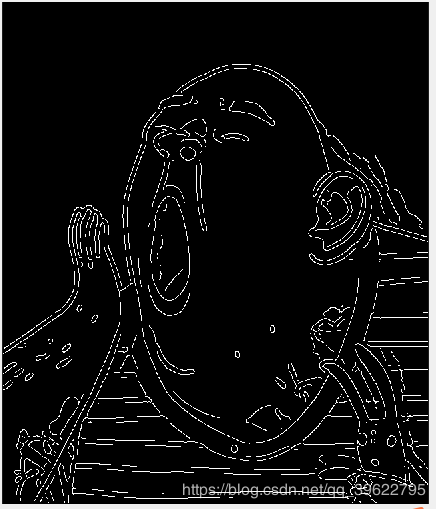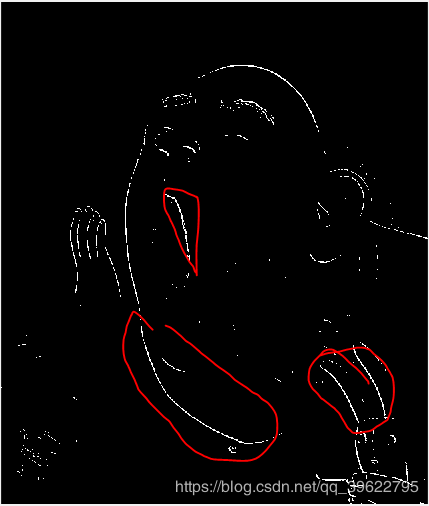边缘检测——利用edge函数
边缘检测——利用edge函数
- Canny边缘检测器
【g,t】=edge(img,‘canny’,T,sigma)
其中T为包含两个阈值的二元行向量,sigma为高斯平滑的标准差,g为处理后的逻辑图像,t为算法使用的两个阈值
Img=imread('F:\20191214162428.jpg');
I=rgb2gray(Img);
I=tofloat(I);
I2=edge(I,'canny',[0.04,0.1],3);
figure,imshow(I2);
%---------------------------------------------------------------------%
function [out,revertclass] = tofloat(inputimage)
% 类型转换
% 单纯的取 x 用的匿名函数句柄(玩的有点花)
identify = @(x) x;
% 将输入转换为单精度的函数句柄
tosingle = @im2single;
table = {'uint8',tosingle,@im2uint8
'uint16',tosingle,@im2uint16
'logical',tosingle,@logical
'double',identify,identify
'single',identify,identify};
% strcmp(s1,s2),输入字符串的数组可以说任意类型组合
% find 找出其中的真值
classIndex = find(strcmp(class(inputimage),table(:,1)));
if isempty(classIndex)
error('不支持的图像类型');
end
% 找到对应的转换类型
out = table{classIndex,2}(inputimage);
% 记录对应逆转换类型
revertclass = table{classIndex,3};
end

2. Sobel边缘检测器
【g,t】=edge(img,‘sobel’,T,dir)
其中T为一个阈值,与梯度比较,dir为想要检测的边缘方向,g为处理后的逻辑图像,t为算法使用的阈值
Img=imread('F:\20191214162428.jpg');
I=rgb2gray(Img);
I=tofloat(I);
[g,t]=edge(I,'sobel',0.1);
figure,imshow(g);
%---------------------------------------------------------------------%
function [out,revertclass] = tofloat(inputimage)
% 类型转换
% 单纯的取 x 用的匿名函数句柄(玩的有点花)
identify = @(x) x;
% 将输入转换为单精度的函数句柄
tosingle = @im2single;
table = {'uint8',tosingle,@im2uint8
'uint16',tosingle,@im2uint16
'logical',tosingle,@logical
'double',identify,identify
'single',identify,identify};
% strcmp(s1,s2),输入字符串的数组可以说任意类型组合
% find 找出其中的真值
classIndex = find(strcmp(class(inputimage),table(:,1)));
if isempty(classIndex)
error('不支持的图像类型');
end
% 找到对应的转换类型
out = table{classIndex,2}(inputimage);
% 记录对应逆转换类型
revertclass = table{classIndex,3};
end
[g,t]=edge(I,'sobel',0.1,'vertical');
Img=imread('F:\20191214162428.jpg');
I=rgb2gray(Img);
I=tofloat(I);
w1=[-2 -1 0;-1 0 1;0 1 2];%最强边缘为-45度方向的边缘
w2=[0 1 2;-1 0 1;-2 -1 0];%最强边缘为+45度方向的边缘
I2=imfilter(I,w1,'replicate');
T=0.3*max(abs(I2(:)));
I3=I2>=T;
figure,imshow(I3);
I4=imfilter(I,w2,'replicate');
T2=0.3*max(abs(I4(:)));
I5=I4>=T2;
figure,imshow(I5);
%---------------------------------------------------------------------%
function [out,revertclass] = tofloat(inputimage)
% 类型转换
% 单纯的取 x 用的匿名函数句柄(玩的有点花)
identify = @(x) x;
% 将输入转换为单精度的函数句柄
tosingle = @im2single;
table = {'uint8',tosingle,@im2uint8
'uint16',tosingle,@im2uint16
'logical',tosingle,@logical
'double',identify,identify
'single',identify,identify};
% strcmp(s1,s2),输入字符串的数组可以说任意类型组合
% find 找出其中的真值
classIndex = find(strcmp(class(inputimage),table(:,1)));
if isempty(classIndex)
error('不支持的图像类型');
end
% 找到对应的转换类型
out = table{classIndex,2}(inputimage);
% 记录对应逆转换类型
revertclass = table{classIndex,3};
end




